-
Paper Information
- Previous Paper
- Paper Submission
-
Journal Information
- About This Journal
- Editorial Board
- Current Issue
- Archive
- Author Guidelines
- Contact Us
American Journal of Condensed Matter Physics
p-ISSN: 2163-1115 e-ISSN: 2163-1123
2012; 2(5): 135-139
doi: 10.5923/j.ajcmp.20120205.05
Electrically Tunable Resonator for Microwave Applications Based on Hexaferrite-Piezoelectrc Layered Structure
A. S. Tatarenko , M. I. Bichurin
Institute of Electronic and Information System, Novgorod State University, Veliky Novgorod, 173003, Russia
Correspondence to: A. S. Tatarenko , Institute of Electronic and Information System, Novgorod State University, Veliky Novgorod, 173003, Russia.
| Email: |  |
Copyright © 2012 Scientific & Academic Publishing. All Rights Reserved.
An electrically tunable microwave resonator based on bilayers with single crystal Zn2Y-type hexaferrite and piezoelectrics of Lead Zirconate Titanate or Lead Magnesium Niobate - Lead Titanate is investigated. The resonator was positioned in a microstripline antenna structure based on alumina substrate. Resonance profiles were obtained for electric field E=0-12 kV/cm; bias magnetic fields H was parallel to the basal plane of hexaferrite. The magnetic and electric tunings of the resonator has been measured. Experimental and theoretical data of research are presented in the frequency range 5-25 GHz.
Keywords: Hexaferrite–Piezoelectric Layered Structure, Microwave Magnetoelectric Interactions, Microwave Devices
Cite this paper: A. S. Tatarenko , M. I. Bichurin , "Electrically Tunable Resonator for Microwave Applications Based on Hexaferrite-Piezoelectrc Layered Structure", American Journal of Condensed Matter Physics, Vol. 2 No. 5, 2012, pp. 135-139. doi: 10.5923/j.ajcmp.20120205.05.
Article Outline
1. Introduction
- In recent years, a demand for signal processing devices in radar detection, communication, and instrumentation started to increase. Wider use of microwave devices in consumer, automotive and industrial radar systems will drive the production quantity up and cost down. With increasing developments in the radioelectronics industry, components have been required to have smaller sizes, higher performance, and multifunctional capability. Microwave technology is moving up to higher frequencies and higher bandwidths, into the mm wave range, up to 100 GHz.Ferrite devices have played a key role in most microwave systems and will continue to do so as they provide unique nonreciprocal and frequency-selective properties. Ferrites are used in tunable microwave and millimeter-wave devices and the tunability is traditionally realized through the variation of a bias magnetic field. This magnetic tuning could be achieved over a very wide frequency range, but is relatively slow, noisy, and requires high power for operation. Similar devices but with some unique advantages could be realized by replacing the ferrite with a ferrite-ferroelectric composite. Such heterostructures are magnetoelectric (ME) due to their response to elastic and electromagnetic force fields.Therefore, composites, especially ferrite-piezoelectric composites, have been attracting more and more attention[1]. When ferrite and piezoelectric phases coexist in one material, novel properties, such as ME properties, are expected due to the interaction between magnetization and electric polarization. Extensive research has been conducted on the ME effect in single phase and composite materials[2, 3].The composites are of interest for the enhancement of ME effects[4, 5].Recently, a great deal of attention has beed devoted to hexagonal ferrites, as microwave materials for the 1÷100 GHz band. To achieve ferromagnetic resonance conditions with spinels or garnets in the mm wave range, there has to be the external bias fields in excess of 20 kG.The idea is to apply permanent magnet materials, which do not require external bias fields in RF operation, because of their very high intrinsic anisotropy they are “self-biased”. The ferrimagnetic oxides, having a crystal structure similar to the mineral magnetoplumbite, are called hexaferrites.Hexaferrites are usually hard magnetic materials, they have high coercivity, and they are used as permanent magnets. Hexaferrites can have an internal anisotropy field up to 35 kG, magnetization up to 5 kG, and high Neel temperature of around 500C. Their operating range situated around the remanence of the rectangular hysteresis loop. Due to the sole Fe3+ state hexaferrites are good insulators, which have very low dielectric losses. The temperature dependence of the magnetization is rather weak, that guarantees good stability.Ferrites with hexagonal crystal structure have a great applied interest for microwave applications. It is a fact, that these materials show a very high uniaxial magnetic anisotropy[6, 7].In electronic equipment for microwaves, single crystal and polycrystalline samples of hexagonal ferrites are successfully used, either because of their exceptionally high internal magnetic fields, or because of the non-linear effects which appear at the relatively low amplitude of the high frequency fields[8, 9].Improvements in the ME response of the composite materials are possible by the use of ferrite materials with narrow ferromagnetic resonance (FMR) linewidth, as well as piezoelectric materials which demonstrate largepiezoelectric coefficient and small dielectric loss.The FMR line of single-crystal Zn2Y hexaferrite can achieve about 8÷13 Oe[10, 11].Ferrite-piezoelectric heterostructures are ideal for studies on wide-band magnetoelectric interactions between the magnetic and electric subsystems that are mediated by mechanical forces. Such structures show a variety of magnetoelectric phenomena including microwave ME effects. The phenomenon can be used for creation of electrical tuning microwave ME resonators and devices on their basis. The specific focus of the ME effects is when electromagnetic modes that are close to FMR become excited in the ferrite. In the presence of an electric field, the piezoelectric deformation in the bilayer structures will manifest as an internal magnetic field in the ferrite. Tunability of the ME devices’ characteristics in the chosen working range can be executed by application of an electric field. This electric tuning is relatively fast and is not power-consuming.The experimental and theoretical studies of ME resonators based on hexaferrite–piezoelectric layered structure in the frequency range 5÷25 GHz are reported in this paper.
2. The Resonator Design and Measurement Procedure
- As the industry turns to monolithic integrated/hybrid nonreciprocal microwave devices, planar geometries have to be used. This requires the development of planar elements, compatible with strip line and microstrip systems. As high-frequency systems are manufactured using Monolithic Microwave Integrated Circuit (MMIC) designs, the size of the ME resonator must be compatible with the MMIC chip technology. In MMIC technology rectangular slabs are used for filters or phase shifters; circular or hexagonal/triangular disks for circulators. The size of a typical ME resonator for the 12÷40 GHz band is about 2.5÷4 mm. These components, depending on the frequency, are films that can be as thick as 0.01÷0.2 mm.The samples under investigation are single crystal Ba2Zn2Fe12O22 (Zn2Y-type hexaferrite) and polycrystalline Lead Zirconate Titanate (PZT) with chemical structural formula Pb[ZrxTi1-x]O3 (0≤x≤1) or single crystal Lead Magnesium Niobate - Lead Titanate (PMN-PT) with chemical structural formula(1-x)[Pb(Mg1/3Nb2/3)O3]-x[PbTiO3] (0≤x≤1). Samples of Zn2Y were prepared by floating zone method. PMN-PT has been formulated to exhibit high piezoelectric coefficients, large electric-mechanical coupling coefficients, and low dielectric losses in comparison with PZT. Commercial PZT850 and PMN-PT32 with <001> orientation were used as piezoelectric phase. The bilayer resonator was formed by Zn2Y hexaferrite thin plate which was 180 μm thick with in-plane dimensions of 3×2 mm2 and PZT disk which was 200 µm thick with diameter of 4 mm or PMN-PT disk which was 500 µm thick with diameter of 5 mm that were bonded by cyanoacrylate superglue. The measurements were carried out for bias magnetic fields H along the basal plane in the range of 100÷4500 Oe. The FMR frequencies were in the range of 5÷25 GHz for these magnetic fields.Resonator positioned over the microstrip antenna with width 0.5 mm, short circuited, and along the long side of the antenna. Layer of Mylar was placed between antenna and resonator (Figure 1).
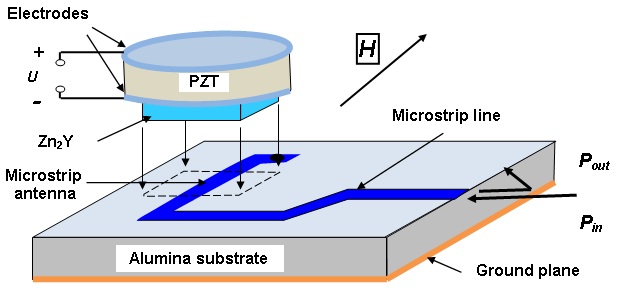 | Figure 1. Schematic diagram of the experimental structure |
3. Theoretical and Experimental Results
- One class of modern planar microwave magnetoelectric devices include circulators, isolators, phase shifters, patch antennas, where the full set of Maxwell's equations should be taken into account to describe the behavior of the system, because the electromagnetic field changes considerably over the size of the ferrite. In another class of devices based on the magnetostatic wave, the wavelength is comparable to the device size, and propagation effects, i.e. the displacement current term in Maxwell's equations, can be neglected. The third class of devices is based on nonlinear effects, when the small signal approximation for magnetization motion is no more applicable.The FMR frequency depends on an internal magnetic field of the ferrite sample. In general case this field consists from the external magnetic field Hext, demagnetizing field Hdem, and the magnetocrystalline anisotropy field HA[11]. In order to increase operating frequencies of the microwave devices the ferrite materials with the increased anisotropy field are necessary. The use of such materials might reduce the weight and the size of the devices. The magneto-crystalline anisotropy field HA is defined as the effective field that causes the same stiffness for rotation of the magnetization over a small angle out of its preferential direction as the magneto-crystalline anisotropy does. In the case of a rotation with constant angle ϕ we get:
 | (1) |
 | (2) |
 | (3) |
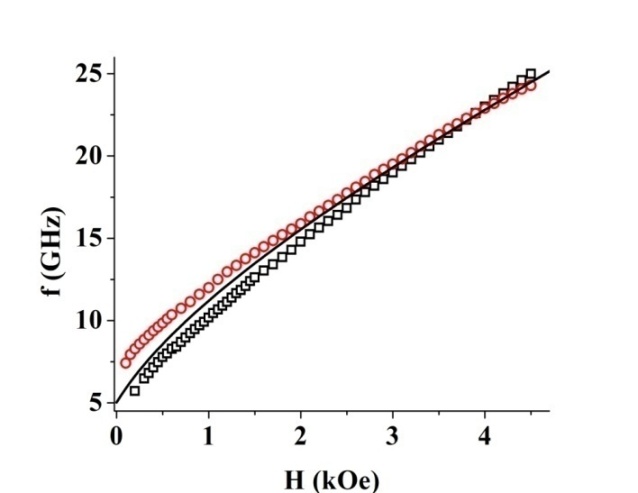 | Figure 2. FMR frequency as a function of magnetic field for free standing Zn2Y sample (black dot is experiment, black line is theory) and Zn2Y-metal structure (red dot is experiment) |
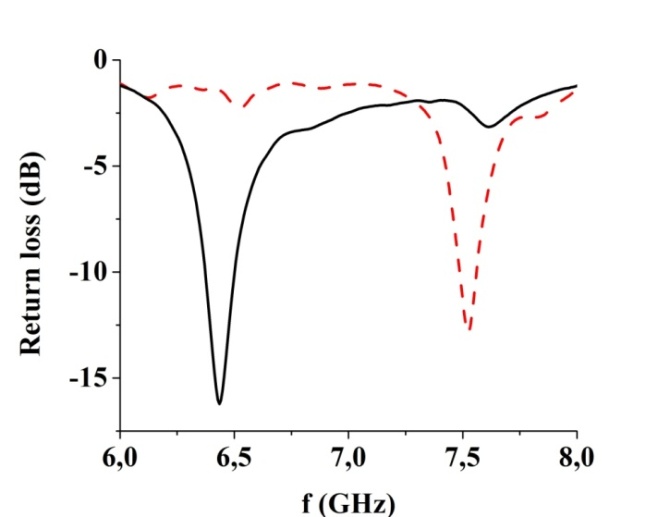 | Figure 3. Frequency response of the ferrite (solid curve) and ferrite-metal (dash curve) resonators for H=400 Oe |
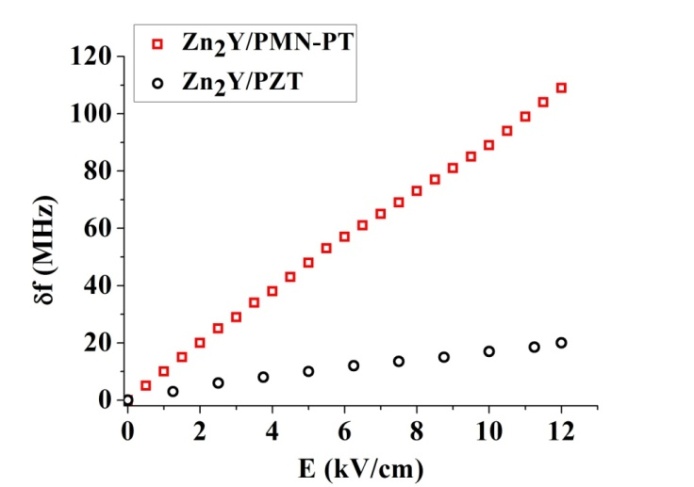 | Figure 4. Dependence of the frequency shift δf vs. applied electric field E. Magnetic field H is 400 Oe for bilayer Zn2Y/PZT and 670 Oe for Zn2Y/PMN-PT resonator |
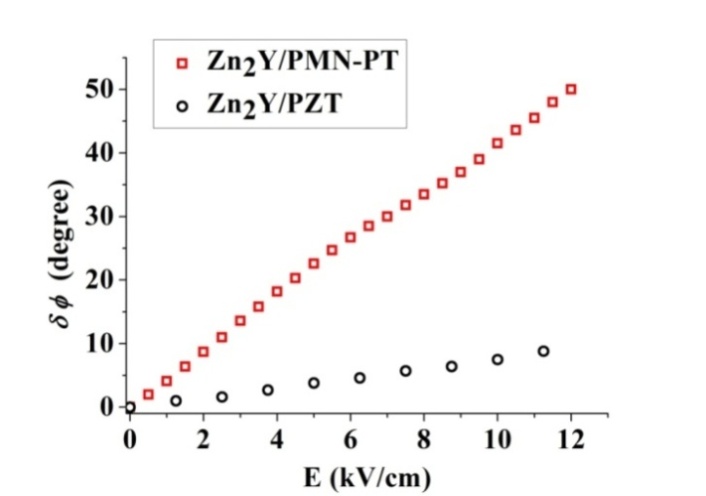 | Figure 5. Dependence of the phase shift δφ vs. applied electric field E. Magnetic field H is 400 Oe for bilayer Zn2Y/PZT and 670 Oe for Zn2Y/PMN-PT resonator |
4. Conclusions
- We investigated the performance characteristics of ME resonator based on hexaferrite-piezoelectric layered structures for microwave applications. The magnetic and electric tunings of the resonator has been measured. The ferromagnetic resonance at frequency range of 5÷25 GHz has been utilized to obtain information on magnetoelectric coupling in bilayers of Zn2Y/PZT or Zn2Y/PMN-PT.The maximum frequency shift of 22 MHz and 109 MHz under the influence of applied electric field has been observed for structures Zn2Y/PZT and Zn2Y/PMN-PT respectively. Also the phase shift of 9° and 50° has been observed at the same structures.The obtained results open up possibility for a new class of magnetoelectric signal processing devices. The unique and novel feature in such devices is the tunability under influence of magnetic and electric field. Miniaturization and weight reduction in microwave devices requires small and thin film-type resonators. A prospective use of microwave ME resonators is in mobile communication devices; magnetically steerable, small-size patch antenna arrays; electrically controlled nonreciprocal devices (variable phase shifters, latching circulators) are operating along the hysteresis loop, controlling the permeability µ directly by applied current (voltage).
ACKNOWLEDGEMENTS
- The work at Novgorod State University was supported by a grant from the RFBR # 11-02-00430-а
 Abstract
Abstract Reference
Reference Full-Text PDF
Full-Text PDF Full-Text HTML
Full-Text HTML